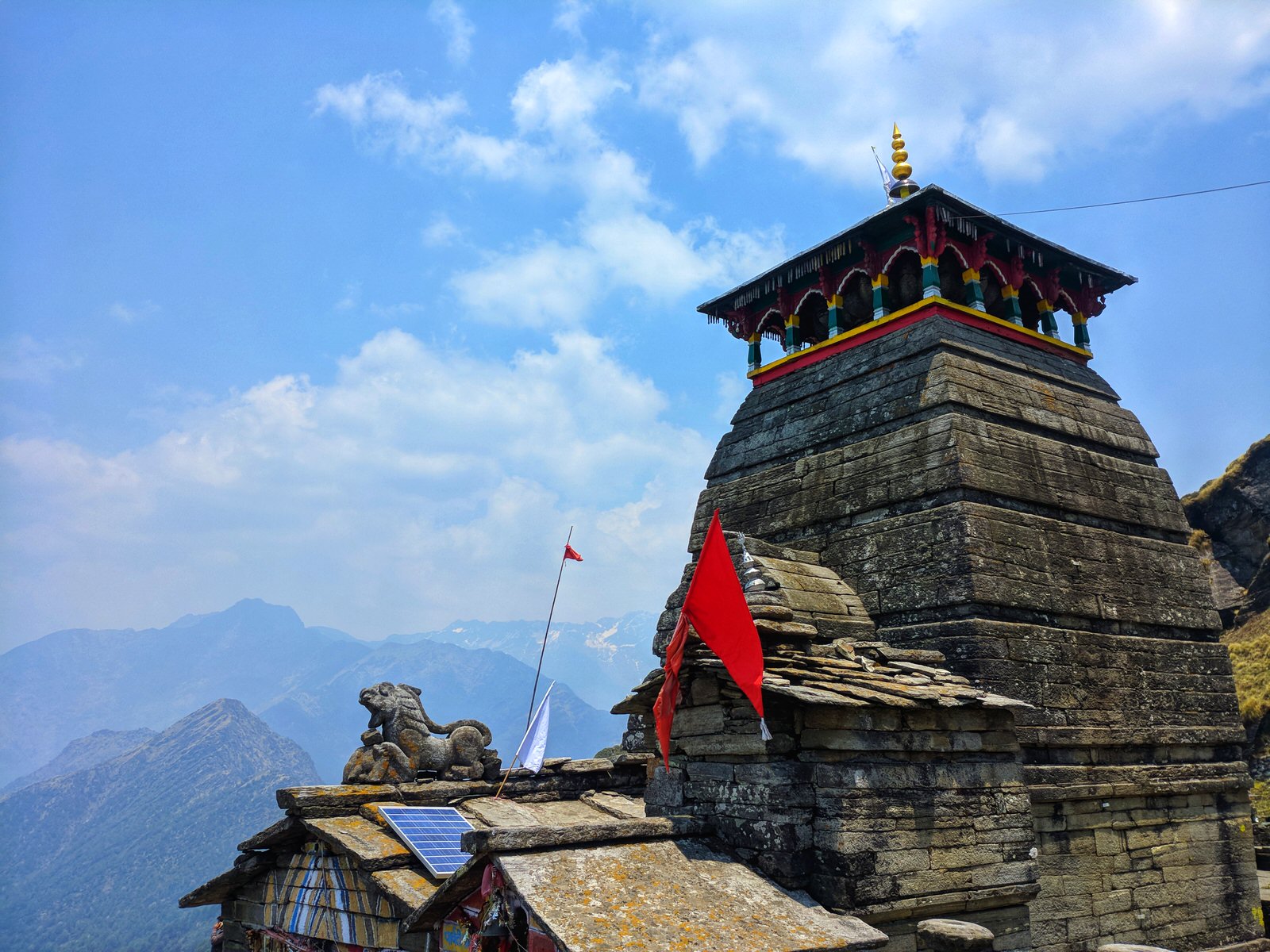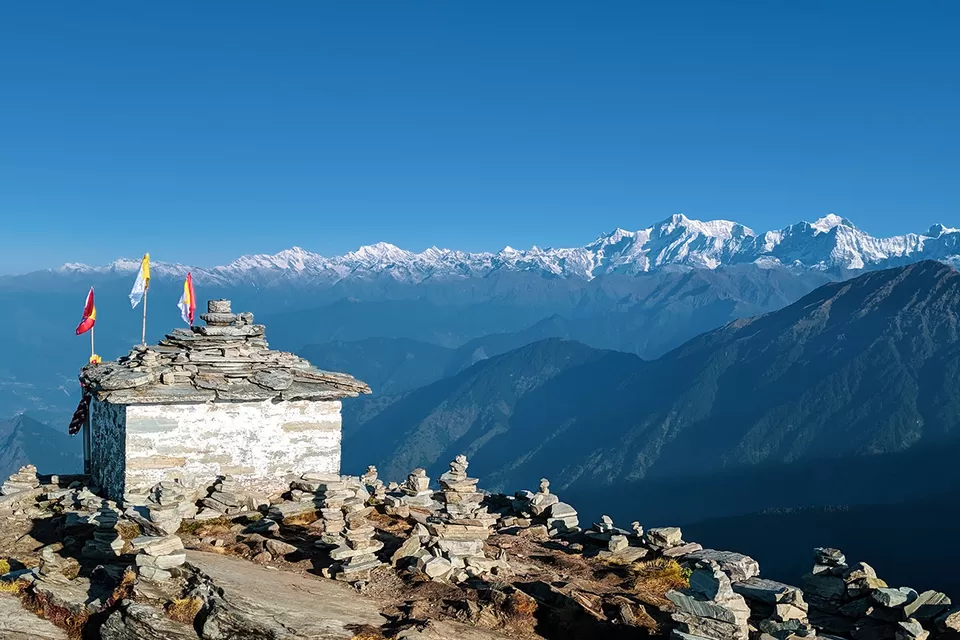Tungnath highest shiva temple
Published on August 23, 2025
Tungnath Temple – The Highest Shiva Temple in the World
Nestled high in the Garhwal Himalayas of Uttarakhand at an altitude of 3,680 meters (12,073 feet), Tungnath Temple is not only the highest Shiva temple in the world but also one of the most peaceful shrines in India. Its name means “Lord of the Peaks,” and true to its title, the temple is surrounded by towering mountains, rolling alpine meadows, and dense rhododendron forests that paint the landscape with bright hues in spring. Away from the chaos of cities, Tungnath feels like a divine retreat where nature and spirituality meet in perfect harmony.
A Temple Steeped in Legend
Tungnath is one of the revered Panch Kedar temples, five sacred shrines of Lord Shiva in Uttarakhand. According to ancient legend, the Pandavas—heroes of the Mahabharata—sought Lord Shiva to absolve themselves of the sin of killing their kin in war. Shiva, unwilling to forgive them immediately, disguised himself as a bull and tried to evade them. When discovered, he disappeared into the earth, and different parts of his body appeared at five different places. The arms of Shiva are believed to have appeared at Tungnath, making it a site of deep spiritual significance.
The temple’s age is estimated to be over 1,000 years, and it is believed to have been restored by Adi Shankaracharya, the 8th-century saint who revived many pilgrimage routes in the Himalayas. Built entirely of stone in a simple, sturdy style, Tungnath Temple reflects the harsh yet beautiful Himalayan environment where it stands.
A Journey Through Nature’s Beauty
Reaching Tungnath is a short but enchanting trek. The 3.5-kilometer trail begins at Chopta, a serene hill station often called the “Mini Switzerland of India” for its pristine meadows and panoramic mountain views. Unlike many Himalayan treks, this path is considered relatively easy, making it ideal for beginners, families, and first-time trekkers.
In spring, the entire trail is lined with rhododendron flowers in full bloom, creating shades of deep red, pink, and purple against the backdrop of green forests. In summer and autumn, the weather is pleasant, the skies are clear, and the surrounding peaks—Nanda Devi, Trishul, Chaukhamba—stand proudly in sight. During winter, the same path transforms into a snow-covered wonderland, perfect for those who love snow trekking.
Along the way, small tea stalls and resting points welcome travelers, offering a warm cup of chai or Maggi noodles to refresh tired legs. The trek itself takes around 2 to 3 hours at a relaxed pace, giving you enough time to enjoy the scenery, click photographs, and soak in the silence of the mountains.

The Sacred Calm of Tungnath
Arriving at Tungnath Temple is a heartwarming experience. The shrine is small yet radiates a powerful spiritual presence. Its black stone Shiva lingam is worshipped with deep reverence by priests who belong to nearby villages. Unlike crowded pilgrimage sites, Tungnath retains its calm and simplicity.
Here, you won’t hear the constant buzz of traffic or temple markets—only the cool mountain breeze, the soft ring of temple bells, and chants of “Har Har Mahadev” by visiting devotees. The peace is so profound that even those who come purely for adventure feel an unmistakable sense of devotion.
From the temple premises, sweeping views of snow-clad Himalayan peaks greet you. As clouds drift lazily across the sky, the sunlight reflects off distant summits, creating golden and silver hues that make the entire scene look surreal.
Seasonal Rhythm of Worship
Like many high-altitude temples, Tungnath remains open only for about six months each year, usually from late April or early May to November. Heavy snowfall in winter makes the shrine inaccessible, and during this period, the idol of Lord Shiva is ceremoniously moved to a nearby village called Makkumath for worship.
This seasonal rhythm adds to the charm and sacredness of the temple. Pilgrims plan their visits carefully, knowing that their time to bow before the deity is limited to just a few months each year.
Chandrashila Summit – The Icing on the Cake
Just 1.5 kilometers above Tungnath lies Chandrashila Peak, which means “Moon Rock.” The trek from the temple to the summit is short but steep, taking around an hour. From the top, you are rewarded with a breathtaking 360-degree view of some of the most famous Himalayan peaks, including Nanda Devi, Chaukhamba, Kedarnath, and Trishul.
Sunrise from Chandrashila is particularly magical. As the first rays of dawn light up the snowy mountains, the entire sky glows in shades of orange and pink, leaving travelers awestruck. Many visitors to Tungnath make it a point to continue up to Chandrashila to complete their journey on a truly high note—both literally and spiritually.
Why Tungnath is Special
Tungnath Temple is more than just a pilgrimage site. It is a rare blend of spirituality, adventure, and natural beauty. For devotees, it is a sacred place where prayers feel more heartfelt, where the thin air and lofty mountains make them feel closer to the divine. For travelers and trekkers, it is an easy gateway to the high Himalayas, offering postcard-perfect views without the difficulty of long expeditions.
Whether you visit to offer prayers, to experience the thrill of an easy Himalayan trek, or simply to take a break from everyday life, Tungnath leaves you with peace, positivity, and lasting memories. The temple’s setting teaches an important lesson: that faith and nature can coexist beautifully when treated with respect.

Best Time to Visit Tungnath
-
Spring (April–June): The trail is colorful with blooming rhododendrons and pleasant weather.
-
Autumn (September–November): Clear skies, mild temperatures, and stunning mountain views.
-
Winter (December–March): The temple is closed, but the snow-covered trek to Tungnath and Chandrashila attracts adventure lovers.
Useful Tips for Visitors
-
Fitness Level: The trek is easy to moderate, suitable even for beginners. Still, walking regularly before your trip helps prepare for the climb.
-
Clothing: Carry warm layers even in summer, as temperatures can drop quickly at high altitude.
-
Trekking Gear: Good shoes, a rain jacket, and a walking stick are helpful.
-
Stay Options: Simple guesthouses and campsites are available in Chopta, which is the base point for the trek.
-
Respect Nature: Do not litter, and try to maintain the temple’s serene atmosphere by avoiding loud music or noise.
A Journey You’ll Never Forget
Visiting Tungnath Temple is a unique experience that combines the serenity of spiritual worship with the thrill of a Himalayan trek. The sight of the tiny stone temple standing proudly against massive snow peaks reminds you of nature’s power and the timeless devotion of those who built it centuries ago.
Whether you bow your head before the Shiva lingam, watch the sunrise from Chandrashila, or simply sit quietly to feel the cold wind on your face, Tungnath leaves you with a rare sense of fulfillment. It’s a journey that stays not only in your travel diary but also in your heart forever.
.jpg)